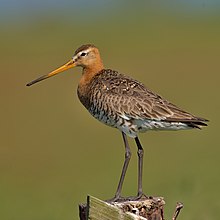Limosa limosa
| Black-tailed godwit | |
|---|---|
 |
|
| breeding plumage | |
| Scientific classification | |
| Kingdom: | Animalia |
| Phylum: | Chordata |
| Class: | Aves |
| Order: | Charadriiformes |
| Family: | Scolopacidae |
| Genus: |
Limosa Brisson, 1760 |
| Species: | L. limosa |
| Subspecies: |
L. l. limosa Linnaeus, 1758 |
| Binomial name | |
|
Limosa limosa (Linnaeus, 1758) |
|
 |
|
| Range of L. limosa Breeding range Resident range Wintering range | |
| Synonyms | |
L. l. islandica Brehm, 1831
L. l. melanuroides Gould, 1846
Scolopax limosa Linnaeus, 1758
The black-tailed godwit (Limosa limosa) is a large, long-legged, long-billed shorebird first described by Carl Linnaeus in 1758. It is a member of the Limosa genus, the godwits. There are three subspecies, all with orange head, neck and chest in breeding plumage and dull grey-brown winter coloration, and distinctive black and white wingbar at all times.
Its breeding range stretches from Iceland through Europe and areas of central Asia. Black-tailed godwits spend (the northern hemisphere) winter in areas as diverse as the Indian Subcontinent, Australia, western Europe and west Africa. The species breeds in fens, lake edges, damp meadows, moorlands and bogs and uses estuaries, swamps and floods in (the northern hemisphere) winter; it is more likely to be found inland and on freshwater than the similar bar-tailed godwit. The world population is estimated to be 634,000 to 805,000 birds and is classified as Near Threatened.
The black-tailed godwit is a large wader with long bill (7.5 to 12 cm (3.0 to 4.7 in) long), neck and legs. During the breeding season, the bill has a yellowish or orange-pink base and dark tip; the base is pink in winter. The legs are dark grey, brown or black. The sexes are similar, but in breeding plumage, they can be separated by the male's brighter, more extensive orange breast, neck and head. In winter, adult black-tailed godwits have a uniform brown-grey breast and upperparts (in contrast to the bar-tailed godwit's streaked back). Juveniles have a pale orange wash to the neck and breast.
...
Wikipedia

